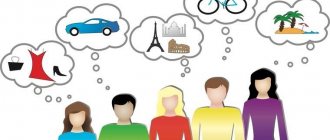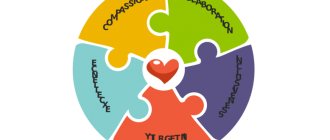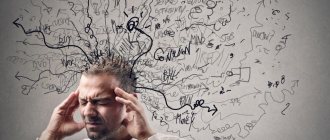Needs, desires, goals are quite similar concepts. This article aims to sort them out in your head, dear reader.
To begin with, I’ll give an example, and then we’ll figure out what’s what.
Mikhrutka is lying on the sofa and he feels good. He's not busy. Suddenly something happens. He feels something unpleasant in his body. Focusing on the sensation, he understands that it is hunger. He thinks: “What should I eat?” and goes through different options. He rejects obviously unattainable foie gras and truffles. Rejects the hated herring under a fur coat and zucchini salad. Then the thought pierces him like lightning: “I want borscht!” He remembers that there is no borscht in the kitchen at the moment. He takes a recipe book from the shelf, looks for the right page and heads to the refrigerator. He takes the necessary products, cuts, fries, steams and voila - borscht! Having eaten it, Mikhrutka contentedly strokes her stomach and lies back on the sofa.
Needs
So, need is a subjective feeling of lack of something.
Please note that “in some way” is not just an indicator that needs are different. This is also a characteristic of need. Because need itself has no object. In our example, Mikhrutka experienced hunger. This is the need for food. But in what food is not clear. The body simply signals: “Let me eat!” Then more or less conscious behavior begins.
The emergence of a need, it should be noted, triggers search activity. That is, a person begins to look for something to do to soothe this “itch” - to satisfy his need.
Desires
Desires are sensations and experiences associated with a conscious desire to get something or experience a certain emotion. The key word is “conscious”.
In simple words, our body dictates our needs in order to survive; we choose our desires ourselves. They are not necessary for our life, but their satisfaction brings tangible joy and pleasure.
Everything seems to be simple. The difficulty begins when marketing comes into play.
For the sake of selling some goods and services, advertising lowered desires to the level of needs, so that a person not only wanted to get it, but thought that it was vital for him.
There is a blurring of concepts, which sometimes works in the opposite direction. Some people buy a brand new iPhone because advertising presents it as a need to strengthen their status, others do not allow themselves a new pair of shoes, because these are all stupid desires and not urgent needs.
Desires answer the question “what do I want?”, and many forgot how to ask this question back in childhood. The education system and stereotypes imposed by society suppress the spark of interest and self-knowledge. But they are the main levers of the question “what do I want?” Therefore, you have to want to learn again.
Motives or desires
In psychology this is called motives. A motive or desire is an objectified need . What does it mean - “objectified”? This means that a clear object appears in the environment that satisfies this need. In the example with Mikhrutka, this is food. Indeed, hunger (the need for food) is best realized by food. This is such a complex thing - psychology.
The motive narrows the search activity. Now Mikhrutka will look in the environment not for everything that can satisfy him, but for food.
Goals
Motivation in business
A goal is the result of forming an image of a result . That is, specifying your desire. Mikhrutka wants not just food, but specifically borscht. In order to make it, you need to find out what resources are required, make sure that the resources are there, make sure that the chosen object is suitable for the person (Mikhrutka reaches into the cookbook, remembers what is in the refrigerator, sweeps away the foie gras and the hated herring under her fur coat).
Then you need to take some actions and eventually come to a result. A whole chain of complex actions is necessary to achieve the goal.
The longer the need is not satisfied, the less demanding the censor is, rejecting options. For example, if Mikhrutka is not fed for a week, he will happily agree to herring under his fur coat, even if he is allergic to it. One of the main things you need to know about goals is that they are specific and therefore achievable (as opposed to a desire), and they are also conscious, take into account and take into account resources. The correct goal, in fact, sets an algorithm of actions to achieve it. This is why many psychologists from the business world rely so much on goal setting.
Needs and motives: definition and fundamentals of psychology
Needs and motives are the main driving forces that motivate a person to action. Psychologists and sociologists have always paid close attention to the study of this issue.
Needs and motives force a person to act. The first category represents the original form of activity. A need is a need that must be satisfied for normal life. Moreover, it can be conscious or unconscious. It is worth noting the following basic characteristics of human needs:
- strength is the degree of desire to satisfy a need, which is assessed by the degree of awareness;
- frequency is the frequency with which a person has a particular need;
- way of satisfaction;
- subject content - those objects through which the need can be satisfied;
- sustainability – maintaining the influence of needs on certain areas of human activity over time.
Needs and motives are quite complex categories. They include many levels and components. So, Lomov B.F., speaking about needs, divided them into three main groups:
- basic - these are all the material conditions for ensuring life, as well as rest and communication with others;
- derivatives are a need for aesthetics and education;
- the group of highest needs is creativity and self-realization.
Needs and motives have a multi-level structure. Only when the needs of the lower order are fully satisfied do more sublime ones appear. Based on this, A. Maslow proposed the following hierarchy of needs for consideration:
- Physiological needs. These are food, water, oxygen, clothing and shelter. If these needs are not satisfied, there can be no talk of any others.
- Safety. This refers to a stable situation that instills confidence in long-term survival. Most often we are talking about financial well-being.
- The need to belong. A person needs to be attached to someone. These are family, friendship and love connections.
- The need for respect. Having a solid foundation in the form of the three previous levels, a person begins to need public approval. He wants to be respected and needed.
- Self-actualization is the highest level of needs. This means continuous personal and career growth.
Despite the fact that this hierarchical system is considered generally accepted, many researchers (for example, A. N. Leontyev) disagree with it. There is an opinion according to which the sequence of emergence of needs is based on the subject’s sphere of activity and his personal characteristics.
Need, motive, action. It resembles something like an algorithm. However, to understand how this mechanism works, it is important to understand the basic features of needs. It is worth paying attention to the following points:
Need for kittens
It is quite obvious that a person’s needs have always been the same. Well, maybe they changed a little due to the development of the brain. But we have already climbed completely into the depths of centuries. Let's say, people who lived during the era of the Roman Empire had exactly the same needs as you and me.
The difference is that the way these needs are met has changed. That is, if previously, to satisfy hunger, a person chose from a narrow menu based on what grows in a given area, now almost everyone can afford almost any food from any country in the world.
We can say that now people want more. They want a new computer, they want fast Internet, they want likes for their avatar. Such things did not exist in ancient Rome, so you can want more? We should not forget that these are just ways to satisfy needs. There is no need for a like, there is no need for an iPad, there is no “lack of cats in the body” or “an urgent need for a Lexus.” All of these are goals at best, and more often desires.
A person wants an iPad not to satisfy the need for an iPad, but for something else. What need he has that desire serves is an individual aspect that can be explored during counseling or therapy. This could be a desire for recognition (wow, how cool you are), socialization (do you also have an iPad? Cool! What games do you play?), comfort (it’s more convenient to read a feed while lying on the couch), and so on.
You can learn a lot about yourself by trying to understand the need that is served by one or another desire. Try it sometime.
Satisfying needs with work.
Labor as a type of human activity.
The needs and interests of people are the basis that determines the purpose of work. Labor in the proper sense of the word arises when human activity becomes meaningful, when a consciously set goal is realized in it - the creation of material and spiritual values necessary for people's lives. In this way, work activity differs from educational activity, aimed at acquiring knowledge and mastering skills, and gaming activity, in which it is not so much the result that is important, but the process of the game itself.
Sociologists characterize work activity, regardless of the method, means and results, with a number of general properties.
Firstly
, a set of labor operations prescribed to be performed at certain workplaces. In each specific type of labor activity, labor operations are performed, which include various labor techniques, actions and movements. As a result of the introduction of new equipment and modern technologies into the content of the labor process, the relationship between physical and mental labor, monotonous and creative, manual and mechanized, etc. is changing.
Secondly
, labor activity is characterized by a set of relevant qualities of the subjects of labor activity, recorded in professional, qualification and job characteristics. Let us remind you that qualifications should not be equated with professionalism. It is a necessary but not sufficient condition for effective work. To become a professional, a person needs to gain experience, he must be characterized by commitment, self-discipline, business integrity, and responsibility.
Third
, labor activity is characterized by material and technical working conditions. To achieve a goal in work activity, as in any other activity, various means are used. These are, first of all, various technical devices necessary for production, energy and transport lines and other material objects, without which the labor process is impossible. All of them together constitute the means of labor. During the production process, there is an impact on the subject of labor, i.e., on materials undergoing transformation. For this purpose, various methods are used, which are called technologies. For example, you can remove excess metal from a workpiece using metal-cutting equipment, but using the electric pulse method allows you to achieve a similar result 10 times faster. This means that labor productivity will increase 10 times.
The modern technical base of enterprises is a complex combination of different types of labor tools, therefore there is a significant differentiation in the level of technical equipment of labor. This entails its significant heterogeneity. A large number of workers are engaged in monotonous, uncreative work. At the same time, many perform work that requires active mental activity and solving complex production problems.
Fourth
, labor activity is characterized by the method of organizational, technological and economic connection of labor subjects with the means and conditions of their use. The most important feature of people’s work is that it usually requires joint efforts to achieve their goals. However, collective activity does not mean that all members of the team creating a product do the same work. On the contrary, there is a need for division of labor, due to which its efficiency increases.
It is obvious that the work of an entrepreneur, characterized by a high degree of independence and financial responsibility for the decisions he makes, differs from the nature of the work of an employee, who, under the terms of the employment agreement, is obliged to carry out the orders of production managers. In 2001 in Russia, the share of employees was 93% of all employees, the share of employers was 1.4%, and the share of individuals engaged in self-employment was 5%.
Fifthly
, labor activity is characterized by the structure of organization and management of the labor process, norms and algorithms that determine the behavior of its participants. In particular, the concept of discipline is very important. Normal work activity is impossible without the voluntary, conscious observance by each employee of the rules and procedures of behavior in the team, which are mandatory for all its members. Labor laws and internal labor regulations require productive use of working time, conscientious performance of one's duties, and high quality work. Fulfillment of these requirements is labor discipline.
Working conditions are of great importance. They include the degree of danger or safety of the object and means of labor, their impact on the health, mood and performance of a person. Potentially dangerous factors are physical (noise, vibration, increase or decrease in temperature, ionizing and other radiation), chemical (gases, vapors, aerosols), biological (viruses, bacteria, fungi).
Work culture plays a big role. Researchers identify three components in it. Firstly, it is the improvement of the working environment, that is, the conditions in which the labor process takes place. Secondly, this is the culture of relationships between labor participants, the creation of a favorable moral and psychological climate in the work team. Thirdly, the participants in the labor activity understand the content of the labor process, its features, as well as the creative embodiment of the engineering concept embedded in it.
Labor activity is the most important field of self-realization in the life of any person. It is here that a person’s abilities are revealed and improved, it is in this area that he can establish himself as an individual.
Satisfying needs with work.
People have different attitudes towards their work. Some do not overburden themselves with work and work coolly. Others are literally “burning” at work. When they come home, they continue to think about what they did not manage to do during the day. The latter are tied to work, while the former are alienated from it. It is for those who are “burning” at work that work becomes the central vital interest.
The concept of “central life interest” was introduced in 1956 by a prominent specialist in industrial sociology, Robert Dubin. The idea turned out to be so fruitful that an entire concept arose based on it. It includes the following provisions:
1. The center of a working individual’s life is his work; everything that happens at work affects every other aspect of his life.
2. People constantly strive for satisfaction, no matter what they do: if a job does not bring satisfaction, they change it.
3. People work only for satisfaction, and nothing more.
4. A satisfied employee is the most productive; on the contrary, those who are dissatisfied with their work are less productive.
5. People can be motivated by increased satisfaction.
6. A satisfied worker is highly integrated both within and outside of work.
7. A satisfied worker usually does not experience depressive emotions such as disappointment, fear, depression, guilt, vindictiveness, horror and envy.
8. Contentment equals happiness; Therefore, every effort should be directed towards making the existence of the worker in the field of his occupation as happy as possible...
Job satisfaction does not really have the meaning that is given to it. Work is only one aspect of a person’s life, but not his only goal, the justification of his entire existence. But this is true until the person loses his job. At this moment we realize that work is something that a person cannot do without. If without work human existence loses meaning, it means that work turns into the first vital need, that is, the central life interest.









